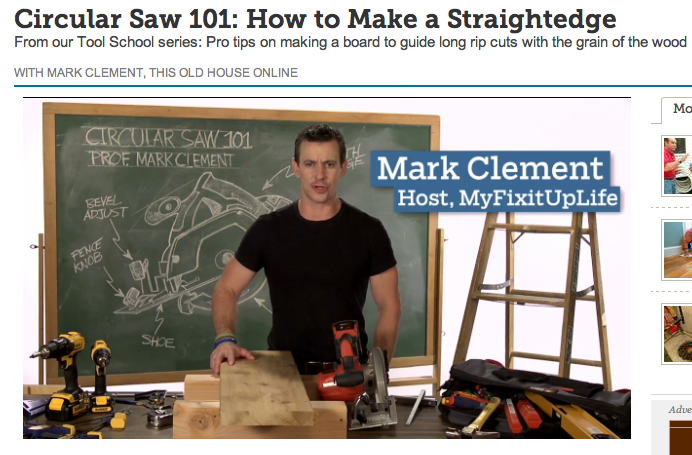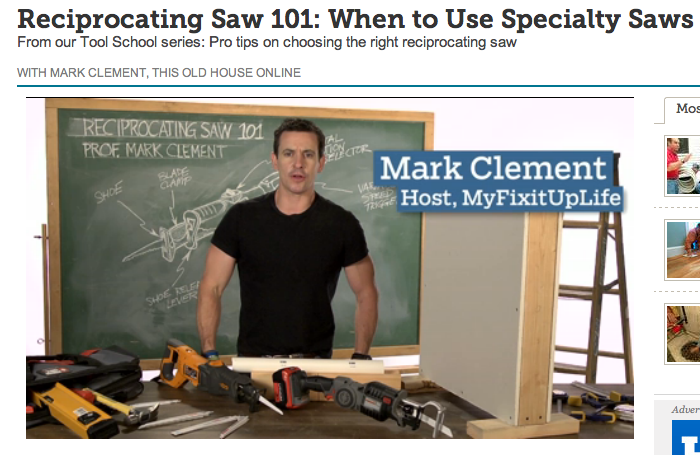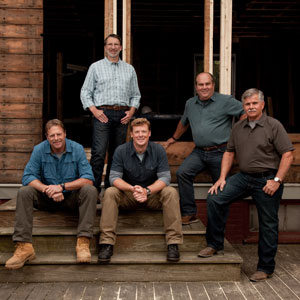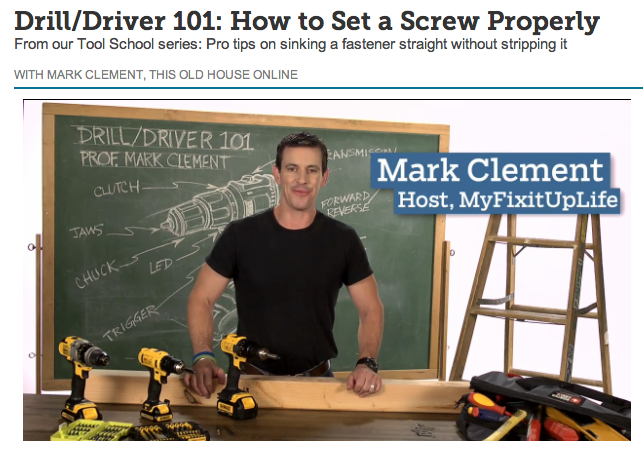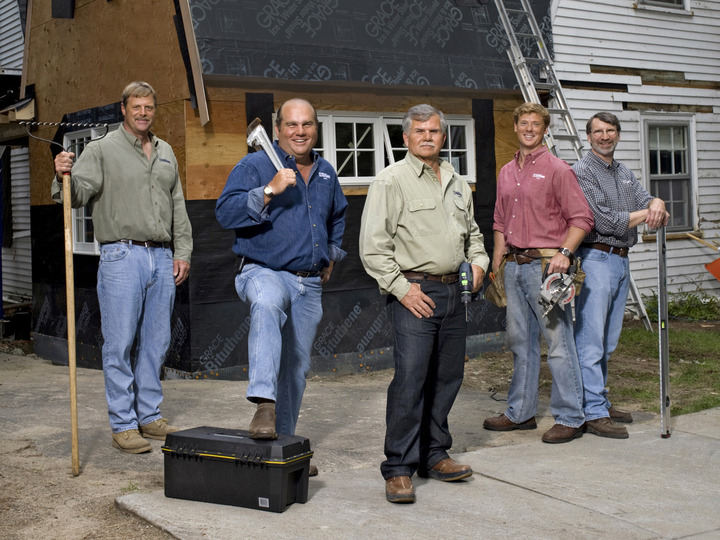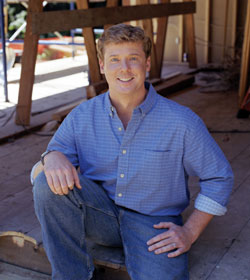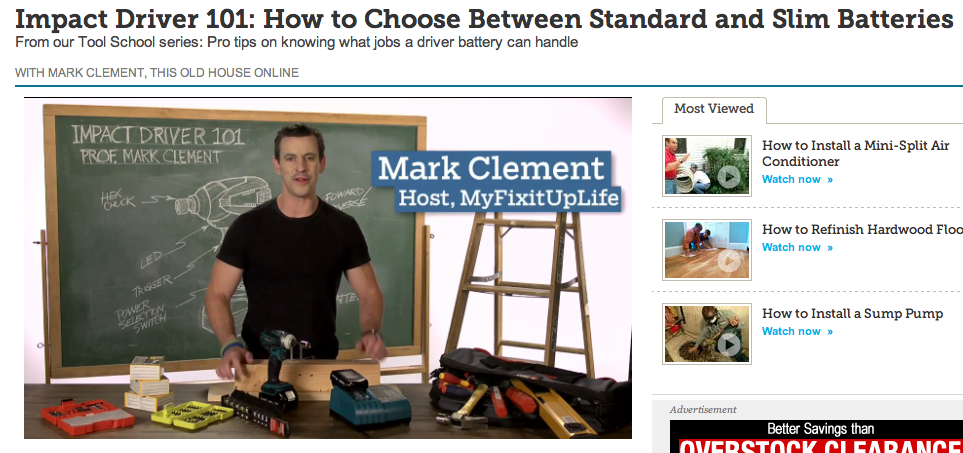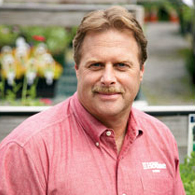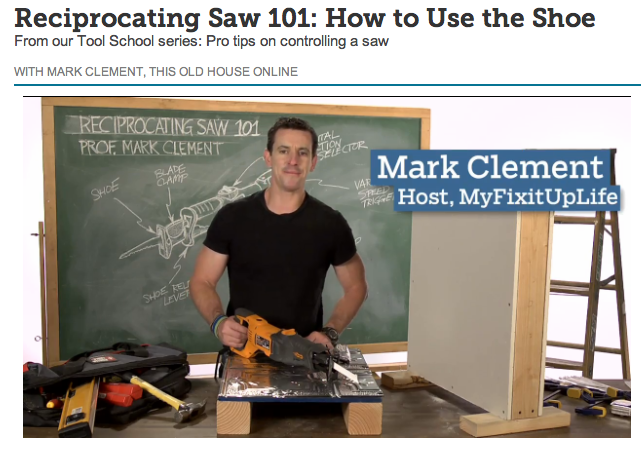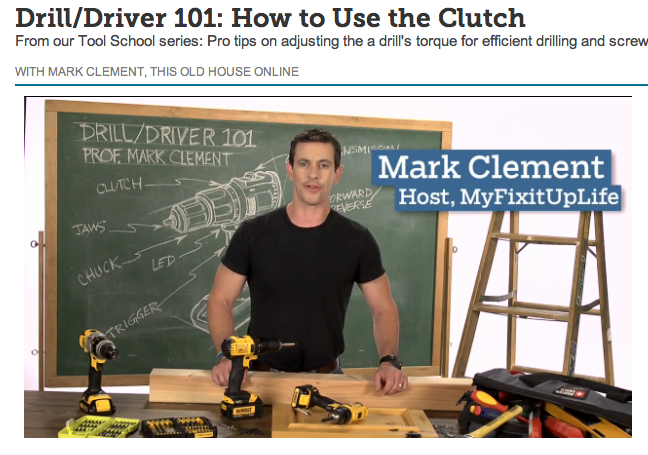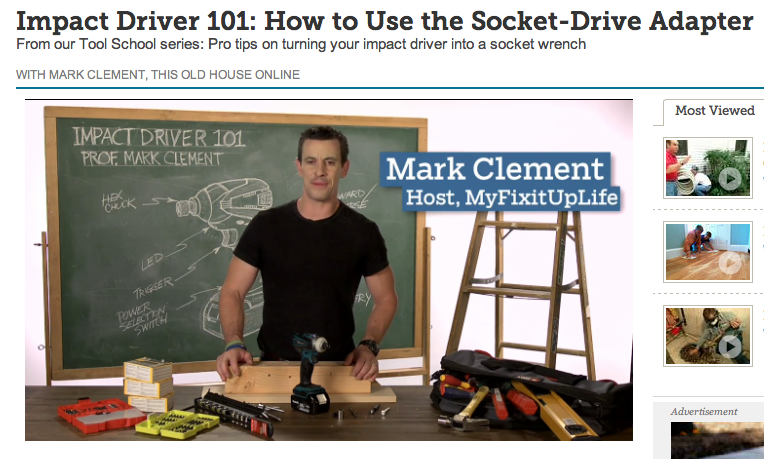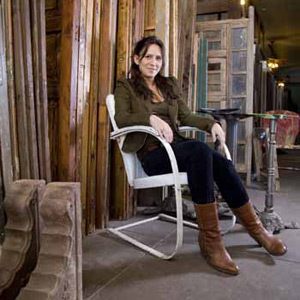
Amy Hughes from ‘This Old House’ talks Salvage Style
Theresa: And you are inside MyFixitUpLife with my fix-it-up husband, Mark.
Mark: And my fixed up, beautiful, architecturally relevant wife, Theresa.



Theresa: Architecturally relevant?
Mark: That’s right.
Theresa: So I like fit in with our home and with you and stuff?
Mark: That’s right, yeah. It’s not random how you put yourself together. It’s form, it’s function, it’s the whole thing.
Theresa: I guess that’s a compliment.
Mark: Yeah.
Theresa: An odd compliment.
Mark: Well you’ve got to know about super architecture stuff, like me, to understand that.
Theresa: You’re super architecture stuff?
Mark: That’s right.
Theresa: Okay. I think I would rather talk to our guest, Amy Hughes, right now from This Old House. How are you doing Amy?
Amy: I’m great. And I’m so glad you both are so architecturally coordinated. I wish my husband and I could be so coordinated. I’m the only one in my house who cares about such thing.
Theresa: Oh, that’s kind of sad.
Amy: Well you know, actually I think it’s kind of wonderful because we don’t, I think we actually have projects that get done because he doesn’t really have a strong opinion about things. He just likes what I do. And I think that that’s a very important thing in a marriage and sometimes some people feel strongly about some things, and he has his stuff and I have mine, and we don’t ever get to an impasse. You know we can start a project and finish a project and both be happy and there isn’t that negotiation — which I kind of like. I think some couples send the other one away you know on a weekend trip with family or something and then they surprise them with the project. But I think that surprise is really about getting a project done the way they want to get it done while the other one is away.
Mark: Ha ha.
Theresa: I think that might be true because I know that when my husband travels, I get a lot more done because we aren’t doing all that negotiation back and forth.
Amy: I think it can be wonderful doing projects together, but I like doing projects with friends who are a little more like-minded.
Theresa: Oh I like that.
Mark: That is really cool. Well tell us about one.
Amy: Well, one of the things that I’m most excited about right now is I have a new book called ‘Salvage-Style Projects,’ it’s out through ‘This Old House’ and what I did — this is something I’ve been working on for seven or eight years, and been following salvage for over a decade actually but it’s sort of a culmination of a ton of projects that I’ve built on my own and also with co-workers and with friends using old house parts so things that I find at salvage yards like an old door, or a piece of a column, or a fence section — like a piece of cast iron or wrought iron, and what I try to do is I take these sort of forlorn pieces and turn them into something really useful and kind of creative.
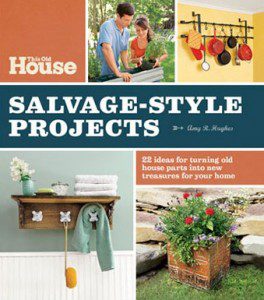


Theresa: And like the old shoe trolley you have as your baker’s rack that I saw.
Amy: Oh you see well I love those projects because I don’t actually have to do anything but clean them up. Find them and clean them up. Finding them can be the hard part. And actually in that case it was more just convincing my father to give it to me because that’s something that he had had and it was just my favorite, favorite thing and when they moved he gave it to me.
Theresa: Now how many times have your parents moved? Because I read you moved 12 times before you were 18 years old. Are they still in the process of that?
Amy: My parents were divorced when I was really young and I moved around a lot with my mom, and it was just because she was a corporate executive, she was in Telecom, but she also used to buy old houses and redo them. So we used to live — and this was back in the day before we had more liberal capital gains tax laws — so she and my step dad would buy these old houses and redo them on the weekends, and then we would live in them for two years and then sell them. And so I moved every two years as a kid. Often I would stay in the same school district, but often not. I mean we would move states in some cases. So I never really got that attached to any place, and as a kid I kind of hated it because I just thought ‘Well I don’t want to move.’ I would stop unpacking my boxes because I knew I would just have to pack them again in two years. So I would just throw a tablecloth over a box and put a lamp on it and call it décor you know. But I somehow picked up the bug and I ended up really kind of following that path as a career.
Theresa: That is so cool because it is sort of in your nature to be able to walk through the salvage yards and be able to look at it, look at the treasures that are there, and not look at it like trash like a lot of people kind of think about it as. And think about it in a creative way too.
Amy: Yeah I mean my mother was really into that and when I was a kid, she and my step dad would buy these really old houses that no one cared about. I mean this was in the 80s when it was sort of the beginning of the preservation movement, and kind of after we lost Penn Station, and people were just starting to think about it and my mom was sort of an ardent preservationist. Just as a hobby, so I grew up in junkyards. They weren’t even called salvage yards at that time, and we would also go into old houses before they were going to be demolished. And one of my favorite memories is actually breaking into a house that was about to be demolished and I don’t think we can get in trouble any more.
Mark: Ha ha yeah the statues of limitations is up on that.
Amy: But it was this beautiful house, and I had lived in suburban New Jersey, and it was about to be torn down and my mom I think knew the contractor and he said go ahead get in. But of course he didn’t meet us there and we ended up climbing through a window and just kind of exploring the house, we didn’t take anything, but part of the house had been damaged by fire and I still to this day think about this one room that was locked and we didn’t have a key and we couldn’t get in. And there were beautiful things in this house, incredible carved wood posts and a beautiful peer mirror which is something I recreated myself years later, but there was this locked room and my mom told me the story — it was like a conservatory, you know the music room. And I still to this day think about what was in there and what we missed. And I think ever since then I’ve been so interested in these old house parts and trying to save them and trying to find uses for them. That kind of work with my lifestyle, I have a family, so I make things into furniture and things that I can really use.
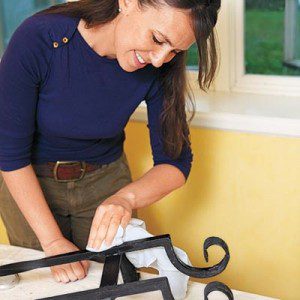


Mark: How does that translate into what you’re working on in the forth-coming issue of the ‘This Old House’ magazine?
Amy: Well this issue, our July issue, is our annual reader creates issue. So this is where our readers and users of our website and fans of the TV show, they basically get on the website on thisoldhouse.com and they submit their projects. And we judge you know their DIY projects and we come up with a winner. So we have a whole house winner and a bunch of one room wonders, I guess I’d call them, and these are people who maybe redo a kitchen or something. But there is also some of our regular departments columns in the magazine and one of those is called Salvage-Style, and this is the column that I produce every month or every other month. That one is first person, it’s the only first person column that we have in the magazine, and so what I was actually able to do with that is I found this old — I believe it was an armoire door — it could have maybe been from a built in cupboard or something, but I think it was an armoire and I had found it on the street in my neighborhood and one of my neighbors was literally the super in this building and was actually bringing it out and was about to put it down on the sidewalk and I just grabbed it and I said ‘If that’s going in the trash I would rather take it home with me now before it sits there too long.’ So I rescued this door from the trash and I brought it home and I was thinking what am I going to do with this thing? So I put it up on Facebook and I created a salvage fan page after the book came out.
Mark: What’s the page?
Amy: It’s Salvage-Style Projects so if you go on Facebook and search Salvage-Style Projects it should come right up.
Mark: Cool.
Amy: And you can also find it, I think, through the This Old House Facebook page as well. But Salvage-Style Projects should give you a direct link to it. So what I did was I just took a picture of the door and I posted it on Facebook and I just said what would you guys do with this? And I got flooded with responses. Between Salvage-Style Projects, and then we reposted it on This Old House Facebook page and then I think one of our readers reposted it somewhere else, and I got over one hundred responses of people saying what to do with it. So what I did is I just kind of went through and counted up the number, you know a lot of people said the same thing, and the overwhelming response was make a table, which to me, having done this for many, many years I thought maybe that’s not the most creative use, but I actually really need a table right now and I thought that’s a pretty simple project and sometimes when you’re doing this kind of work all the time you forget that what I might think is a simple project or too easy, is like the perfect thing for someone who’s just starting to salvage. And I think it’s easy to understand and it’s easy to put together, and it’s incredibly useful. So I said alright I have a 3-year-old and I had gotten rid of, I had a glass table, that I had gotten rid of because I was really afraid she was going to bonk her head on it, and I had gone three years without a coffee table so I thought alright this is the winning one so I’m going to make it, I’m going to follow their suggestion so I was able to produce that for our reader creative issue. And actually do it completely based on suggestions from people through social media. So it was kind of a nice mixture for us to take something that originally started with this book, and then create the fan page out of that book, and then take some ideas from the fan page, and then put it onto the magazine page.
Theresa: So people can check out what you created in the July issue of ‘This Old House’ magazine?
Amy: Yes they can. So it’s a coffee table that I created out of this armoire door and it’s on page 57 of the July issue.
Mark: Oh page 57. That’s awesome.
Theresa: And it’s good for 3 year olds to be around as well.
Amy: It is. I mean I pulled this thing out of the trash and I cleaned it and I sanded it and I waxed it, but I mean what damage can one do to something that’s pulled out of the trash? That’s part of the reason I love working with these old pieces because I like to celebrate their flaws and highlight the flaws in a lot of cases because it’s character and it really makes for easy living. I mean there’s nothing too precious that my three year old can’t doodle, on paper of course, on the coffee table — I don’t mind. And if the crayon marks go over you know no big deal. A little bit of sand paper or a little steel wool to take that right out, put a little bees wax onto and it’s finished.
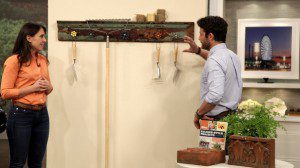


Theresa: Well what my grandmother used to say is those are little love marks and that you’ll treasure them later on in life.
Amy: I thoroughly agree. I don’t get mad about that kind of stuff. You know it’s a family house, and we keep a nice house, and it’s really clean for having a toddler I think, but I like for her to be able to use it. I mean she jumps up on that thing and uses it as a stage sometimes.
Theresa: Well of course, she’s a three-year-old girl.
Amy: Exactly.
Theresa: So people can connect with you at Salvage-Style Projects on Facebook and they can also connect with you too — you’re at Ikeas around the country.
Amy: I am, yes. So this is something completely different. I’ve been doing this with two different co-workers so far where, this is my second year, and about 15 weekends a year I am on the road in Ikea stores around the country in their kitchen cook shops leading kitchen design workshops of sorts. So teaching people how to start at the very beginning, like how to envision what they want for their new kitchen, and then all the way getting into some installation tips and stuff. Now we’ve kind of gotten it down to an hour long seminar, and it’s part of Ikea’s life improvement projects so you can go on Ikeas website, or just Google life improvement projects and your listeners can find — it’s not just me there are other magazines who are doing it as well — but yeah the kitchen workshop has been really fun and we often get anywhere from 20 to 50 people and we sit down and walk them through the whole process. Like how to create a wish list, and what counter top to choose that fits the way you cook and your lifestyle and you level of ability to clean or desire to clean. And you know we talk about cabinet door styles and everything. So that’s been a lot of fun and we’re actually coming to the end of the second year. And the next two, I have a date coming up in Chicago with one of my co-workers, Alex Bandon, here at ‘This Old House’ magazine. And I have one coming up in Stoughton, Mass. with Kevin O’Connor who you all know from the ‘This Old House’ television program.
Mark: Oh that’s super cool and that would be a fun one. And Kevin really knows what’s going on. As much as I want to take this opportunity, as I usually do when his name comes up, and throw him under the bus, Kevin is really a real dealer and he loves what he’s doing so that is also captivating.
Amy: And he’s such a nice guy you don’t really want to throw him under the bus.
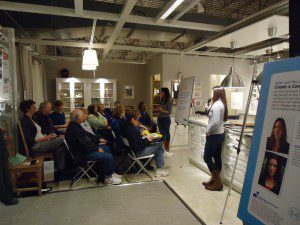


Theresa: He does.
Mark: I cannot admit to that.
Theresa: They are constantly making fun of each other. I think it’s one of those man/brother kind of feelings that you can do with each other.
Mark: Well it’s not fun that we have to…
Theresa: Take a break.
Mark: Take a break.
Theresa: So definitely go to Facebook and check out Salvage-Style Projects, and follow ‘This Old House’ on Twitter @ThisOldHouse, go on thisoldhouse.com, and check out the July issue.
Mark: And we’ll be back with more MyFixitUpLife.
Check out the MyFixitUpLife talk show that features this interview with Amy Hughes.

